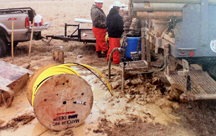Helmut Ernst, the embattled chief engineer of the Big Dig, has been fired, the state transportation secretary said today, as the fallout continued from the controversy over a light fixture collapse earlier this year in one of the project’s tunnels.
Ernst had already been reprimanded and suspended for his role in the state’s failure to notify the public for more than a month after a corroded 110-pound light fixture collapsed onto the highway in the O’Neill Tunnel on Feb. 8.
Transportation Secretary Jeffrey Mullan said the department had finished a review of Ernst’s performance on Friday and concluded he could no longer serve as the District 6 highway director, the former title for his job as a top engineer in charge of the Big Dig tunnels.
Mullan said he offered Ernst other jobs in the transportation department, but Ernst, who has worked as an engineer for the state highway system for two decades, declined to take them.
“As a result of that, we terminated Helmut’s employment at the DOT today,” Mullan told reporters at the state’s highway operations center in South Boston. “It was clear that we lost confidence — I lost confidence — in him, and given some of the issues, someone in a leadership position like that, I would expect more,” Mullan said.
Tom Broderick, currently the chief engineer in the highway division, will replace Ernst while the department searches for a permanent replacement.
The collapse revealed widespread corrosion in lights throughout the 7.5-mile Big Dig tunnel system — and the delay by state officials in notifying the public sparked outrage and concern about the tunnels’ safety.
In an interview in July with the Globe, Ernst said his team of engineers filed no written report about the collapsed light fixtures despite state policy requiring documentation of safety issues. Ernst admitted his engineers had been wary about writing things down since the 2006 collapse of a Big Dig ceiling panel that killed a woman.
“After all the depositions in the ceiling collapse case, we just meet and talk about it … What’s the point of putting it in writing?” he said. He said engineers had been “trained not to.”
Ernst claimed he had called his boss, Frank Tramontozzi — who was forced to resign in March as highway administrator for his own role in mishandling the light fixture collapse — the day after the collapse. Tramontozzi said he didn’t learn about the collapse until Feb. 28.
Ernst also claimed he brought up the collapse at a Feb. 14 senior staff meeting. But seven other staffers, questioned by a staff lawyer at Mullan’s request, said they didn’t remember him mentioning it.
Mullan said he was not pushing out a whistleblower, who had spoken out about problems in the Big Dig. “I don’t think that’s related to it all,” he said.
He said there would not be a chilling effect on other employees, discouraging them from speaking out. “No,” he said. “It just didn’t work out, and sometimes it doesn’t work out.”
Mullan has said he plans to leave his own job by the end of the year, but said today he has not settled on the exact date when he plans to step down.







